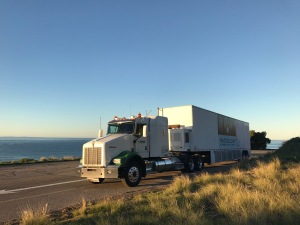by
John R. Fischer, Senior Reporter | June 13, 2022
From the June 2022 issue of HealthCare Business News magazine
By John R. Fischer
Whether it’s a parking lot or a hospital campus, mobile medical imaging trailers are able to go where they’re needed most. This is especially helpful in rural and remote areas that are miles away from the nearest healthcare facility. Even if a provider is nearby, many lack the finances or demand to justify purchasing or updating medical imaging suites. “Mobile allows hospitals to get the latest technology,” said Larry Sodomire, president of TDC Trailer. “In rural America, providers share the unit. If providers are only using it one day a week, then the cost can be as low as $10,000 per month. Using mobile imaging trailers, they do not have to redo their whole suite for millions of dollars.”
Mobile imaging can also be an asset to urban and suburban hospitals with high patient volumes. As many of these providers partner with smaller facilities and expand outward, the need for these units has only increased, says Chad Smith, division president of Armor Mobile Systems and Medical Coaches. And it is a suitable alternative when constructing new imaging suites, as it can help prevent service disruptions and patient backlogs. “If a provider is looking to put a brick-and-mortar building in, sometimes they can have temporary mobiles that facilitate imaging while that structure is being built,” said Smith. “It's less costly and they can bring a medical trailer in there for four or five years and then move it out when they're finished.”
Mobile units are frequently upgraded with the most advanced scanning technologies, making their equipment in many cases superior to fixed solutions. Setting them up is also easier in comparison to brick-and-mortar buildings, because they are not subject to the same building codes and regulations, which vary from location to location.
As many units travel specific routes throughout the week, providers can schedule when they need them most in advance, allowing them to give patients advanced notice of when imaging services will be available.
Having the right imaging modality
In recent years, demand for imaging modalities in mobile units has shifted. Whereas rural hospitals once mainly relied on X-ray and ultrasound, many are now in need of more advanced applications like MR, CT and PET/CT. Patrick Doyle, chief executive officer of mobile imaging company DMS Health Technologies, chalks this up to people living longer, which has led to new and higher rates of illnesses.
“Unfortunately, in the PET/CT market, you have a number of cancers in our society affecting our population. PET/CT is now being used for prostate cancer and for cardiac and for brain conditions,” he said. “With MR, we have a more active society. Everybody you talk to will say, ‘My shoulder hurts, so they’re giving me an MR.’ A lot of it is population growth and the number of scans needed.”
